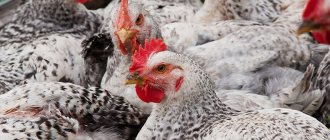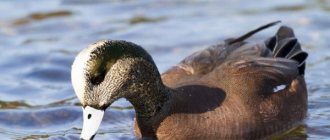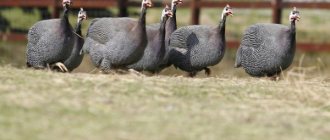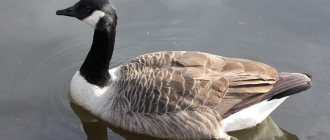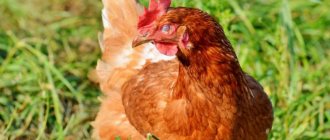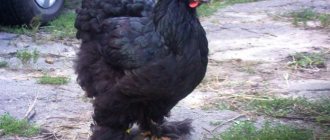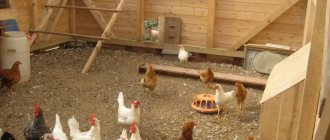Home » Articles about ducks » Cherry Valley ducks: description of the breed
Cherry Valley ducks are similar in genetic characteristics to the Peking breed. They are widespread in Russia. The birds' unpretentiousness to living conditions, strong immunity, and good meat and egg productivity contribute to their popularity.
Description of the Cherry Valley duck breed
Externally, the Cherry Valley duck is similar to the Peking duck. The weight of females is 3.4-3.7 kg, males – up to 4 kg. Their body is oblong and their chest is wide. The legs are thick, red or orange, and are located close to the tail. Adults have a large layer of fat and muscles are unevenly developed. The neck is thick, the head is medium size. The forehead is convex. The eyes are dark blue. The beak is curved, yellow-orange. The plumage is dense and white.
The plumage is dense, white
Interesting!
Breeders distinguish between two lines of the breed - paternal and maternal. The maternal line is characterized by increased egg production, and the paternal line is characterized by rapid weight gain.
Bashkir
Breed of meat and egg orientation. Farmers of private farmsteads and industrial enterprises especially fell in love with these birds, due to the fact that they feed on almost any food and are able to independently satisfy their needs while walking in a meadow or on a pond.
Description. Ducks have protruding chests and a strong and muscular build. Large, widely spaced paws on short orange legs. The head is flattened on the upper side, located on a short, concave neck, curved outward. A concave orange beak with a wide growth that allows the birds to grab grass. The wings fit tightly to the body. The plumage is black-gray.
Productivity. Adult drakes weigh more than 4 kg, and ducks reach 3.7 kg. There is practically no fat in the carcass. The meat yield is at least 70%. One laying hen produces from 115 to 125 eggs weighing 70-80 g per year.
The bird is unpretentious in care, so it will feel good in special cages and pens. In the room for ducks, it is imperative to maintain an average temperature in winter, and set the optimal temperature in summer - it should not be hot.
Advantages. High survival rate of ducklings - about 80%. Birds also have increased resistance to infectious diseases, grow and develop quickly.
Flaws. Birds need to constantly drink clean water and change bedding, otherwise the animals may be susceptible to disease.
Characteristics of Cherry Valley ducks
Also check out these articles
- Strawberry Honey
- Transplanting raspberries in autumn
- Pushkin breed of chickens
- Potato variety Gulliver
The breed is distinguished by high quality characteristics, for which it is valued by farmers around the world.
- Individuals grow quite quickly. Birds at the 7th week of life already weigh about 2.5-3.5 kg. It is at this age that they are usually sent for slaughter. Carcass weight after slaughter – 66-68%.
- The poultry meat is red in color, a bit tough compared to white meat, but quite tender, with excellent taste. The meat is nutritious and contains many minerals and vitamins.
Carcass weight after slaughter – 66-68%
Important!
Cherry Valley duck meat does not belong to the dietary type, because it takes a long time to be absorbed by the body.
- The safety of adult birds is 98%, that of young birds is 95%.
- Females begin to lay eggs at 6-7 months of age.
- Females can produce 120-150 high-quality eggs per year.
- The weight of one egg is about 100 g.
Biological features
Unfortunately, the plumage of these broiler ducks is not very thick. Cherry trees cannot tolerate Russian cold without reducing productivity. In the winter, the barn with these ducks must be heated. However, domestic summer residents breed cherry trees mainly only in the summer. After all, ducks are early ripening and reach slaughter weight by the age of 2-3 months. Therefore, in most cases, not very good resistance to cold does not play a special role when breeding this breed.
Currently, there are two main lines of cherry valley ducks bred on farms: paternal and maternal. In appearance, these two varieties are practically no different. However, their productivity indicators are not the same.
All Cherry Valley ducks love to swim. Therefore, their layer of subcutaneous fat is quite large. For the most successful keeping of these ducks on the farm, it is advisable to equip at least a small artificial pond.
In addition to excellent productivity indicators, farmers consider the good survival rate of young animals to be an advantage of cherry valley poultry. Lunging in a flock of these ducks is rare. The survival rate of Cherry Valley is 92-95% at an early age and 95-98% at the last stages of cultivation.
Maintenance and care
Cherry Valley ducks are not picky when it comes to keeping and caring for them. In order for ducks to lay eggs and grow normally, a comfortable poultry house is set up and some important rules of care are observed.
- The room for keeping ducks is made on the basis that there are up to 3 ducks per square meter of area.
- The room temperature should always be positive. In winter it should not drop below +5 degrees. If you need to get eggs from ducks in winter, then the room temperature rises to +15 degrees Celsius. In addition, ventilation must be established in the duck house.
- Peat, straw or hay are used as bedding. The litter is changed every 3 months or a little more often.
- Perches for ducks are wide bars. They are attached to the walls, at a height of 20 cm from the floor. There should be enough nests for all females (1 nest for 3 ducks).
In spring and summer the bird is released to swim
Important!
Dampness and drafts in the poultry house are excluded, otherwise the individuals will get sick.
- Daylight hours for Cherry Valley ducks should be 12 hours. To achieve this, artificial lighting is provided in the room. Few lamps are installed; it should not be very bright inside. Distribute the light bulbs evenly across the ceiling.
- For the birds to clean their feathers, a basin with sand and ash is placed in the nesting box. Change this mixture every 20-30 days.
- Cleaning is done frequently to keep the inside free of dirt. Birds have white plumage, so they can quickly become dirty. So all surfaces in the duckling house, feeders, drinking bowls, nests and perches need to be cleaned as often as possible.
- The walk is spacious. In spring and summer, the bird is released to swim. If there is no pond nearby, it is worth making a small “pool” for birds or simply placing a wide basin or bathtub with water.
What should a barn be like?
In the warm season, Cherry Valley ducks can be kept either in a permanent poultry house or simply under a canopy - in an aviary. The first option is considered more preferable. If the ducklings are purchased, for example, in mid-late spring, under the canopy they will begin to freeze and get sick. In any case, the optimal ambient temperature for these ducks is 16-25 oC.
As already mentioned, for cherry valley it is advisable to equip a small pond on the site. You can simply dig a hole under the pond, cover its bottom with waterproofing material and fill it with water. Cherry Valley ducklings are allowed to be released to swim only after they have fledged. Bathing is contraindicated for small chicks raised without a brood hen. Such ducklings do not yet have subcutaneous fat. Therefore, in water they can easily become hypothermic. As a result, the kids will definitely get sick.
If it is not possible to arrange a pond, several large troughs with water should be placed in the Cherry Valley enclosure. It is not recommended to place such containers in a permanent poultry house. Cherry Valley cats love to splash around, and in this case the barn will always be damp. And this, in turn, can also cause the bird to become sick.
Possible diseases
We recommend reading our other articles
- Chilli
- Scab on an apple tree
- Snapdragon flower
- Potato variety Queen Anna
Cherry Valley ducks have high immunity and resistance to a wide variety of diseases. And yet they can hurt in some cases. For example, with poor nutrition, they become deficient in vitamins, which in turn leads to diseases such as conjunctivitis and vitamin deficiency. The lack of any substances can be noticed by the behavior of birds. Usually they start eating small stones, sawdust, and plucking feathers. To solve the problem, the diet is improved and premixes are included in the feed.
Cherry Valley ducks have high immunity and resistance to a wide variety of ailments
In addition, sudden changes in temperature lead to the appearance of colds, omphalitis or catarrh. The main symptoms are inactivity and loss of appetite. If the bird is given stale food, then problems with the intestines and stool begin.
To prevent birds from getting sick, and if something happens, to recover quickly, you need to call a veterinarian at the first sign of illness. Sick individuals are usually isolated and treated with a prescription from a veterinarian. The rest of the herd is undergoing preventative treatment.
Appearance of the bird
The plumage of the Cherry Valley cross, like its ancestor, the Peking duck, is completely white. The legs and beak of these hybrids are bright orange. Characteristic features of the breed are also:
- wide and dense neck;
- protruding chest;
- medium-sized head with a convex forehead;
- dark blue eyes;
- vertical body position.
In general, the Cherry Valley duck is actually a very powerful and massive bird. The photo below certainly confirms this.
What to feed Cherry Valley ducks
In order for Cherry Valley ducks to develop properly and grow quickly, it is necessary to provide them with a balanced diet. Birds of this breed are fed differently. You can use mixed feed, dry grain mixtures, granulated vegetables with vitamins, wet mash with herbs and vegetables.
Food is given 2-3 times a day
Food is given 2-3 times a day. If the birds are allowed to walk outside during the day, then they need to be fed only 2 times - morning and evening, but if the ducks do not walk during the day, then they must be fed 3 times a day.
In winter, the diet includes premixes, young plant branches, silage, vegetables, and sprouted grains. This allows you to diversify your diet, improve food absorption during the cold season and reduce the risk of vitamin deficiency.
Feeding
The principles of feeding young animals and broodstock are different.
The young animals are fed with the feed "Start", "Growth" and "Finish" for 3 weeks. It is allowed to keep young animals on mixed feed during the entire fattening period. To reduce the cost of rearing, it is recommended to refuse feed at the age of 3 weeks and raise poultry using :
- mixtures of steamed wheat, corn, barley, oats;
- minced meat after heat treatment;
- boiled potatoes;
- bran;
- skim milk or curdled milk;
- meat and bone broth;
- salt;
- bone meal;
- chopped fresh herbs or herbal granules.
Similar nutrition should be used when keeping broodstock, reducing the nutritional value of the feed to prevent bird obesity.
- Stern
- Recipes
Rating of food for ducks and ducklings
Ready-made feed for ducks. Comparative characteristics and consumption rates
Read
What to feed turkey ducks
How to feed turkey ducks. Feeding standards from birth to slaughter to obtain tasty meat
Read
What to feed mulards
Balanced diet for quick weight gain at home
Read
Feeding ducklings and adult ducks
Feeding meat and egg-laying ducks and ducklings at home. Examples of diets depending on the period
Read
Breeding
Cherry Valley ducks begin laying eggs at 7 months or a little earlier. The bird has a maternal instinct, so breeding is usually carried out using a natural method. At one time, up to 20 eggs can be laid in the nest under the female.
For the first couple of days, the female simply sits on the eggs. From day 3 she can sometimes get up to drink or eat. If she does not do this, you need to carry her to water and food yourself (the feeder and drinker are placed next to the nest) and then put her on the eggs again.
You can lay up to 20 eggs in a duck’s nest at one time.
Important!
When the ducks have just laid eggs, they should under no circumstances be disturbed for the first 2 days. The bird must get used to the clutch, get used to its role. At this time, it is very easy to scare her away and then she will simply get up and not return to the eggs!
Hatched ducklings grow quickly and hardly get sick thanks to their developed immunity. They are covered with thick, yellow down. The female can look after the young herself, so rearing is not labor-intensive, but the breeder must do the feeding.
For the first 10 days, young animals are given chopped eggs, cottage cheese mixed with kefir. From the fifth day, chopped greens are also included (nettle burnt with boiling water, onion feathers, clover). From the 11th day, the diet should already include root vegetables and grain mash for adult individuals. Each new product is introduced into the diet gradually to see the ducklings’ reaction to it. It is imperative that in the poultry house where young animals are raised there must be clean, fresh water, which is changed several times a day.
Hatched ducklings grow quickly and hardly get sick thanks to their developed immunity.
Useful tips
Ducklings should not be given:
- bread;
- dairy products (except cottage cheese);
- flour;
- boiled porridge (except oatmeal);
- berries (strawberries, raspberries, any others);
- grape;
- silage;
- fresh nettle (it must be dried or doused with boiling water);
- onion;
- cabbage;
- sunflower seeds;
- chicken feed;
- maple leaves (causes intestinal blockage and death of chicks).
You can feed corn, peas, legumes, oats, cake, meal, wheat, rye, barley, tomatoes, carrots, grass, and give mineral supplements (chalk, shell rock, bone meal, coarse sand, crushed shells). Vegetables must be chopped and it is best to fill them with water. The bird also loves aquatic vegetation, insects and worms. Small fish can be given only after the ducklings have swum in open water.
Reviews of the Cherry Valley duck breed
Farmers' opinions about Cherry Valley ducks can be found in the reviews below.
- Svetlana Bogorodova : “I decided to try raising Cherry Valley ducks, because they are raised even in large poultry farms, which means they are profitable. And as it turned out, this is indeed the case. Birds grow quickly, their meat is very tasty, juicy, but tougher than chicken, which is quite logical. Growing is not difficult. The main problems of this species are that the birds need daily walks and drink a lot of water.”
- Oksana Mishina : “I like Cherry Valley ducks for their productivity, appearance and simplicity. At one time they were raised with virtually no walking. The birds were disobedient, screamed a lot, and did not eat well. Then they built an enclosure for them, made a small pond and the situation changed radically. Now our ducks lay twice as well, they have become calmer, it is difficult to compare the taste of meat, but the birds are now growing larger and there is not as much fat in them as expected. In general, I recommend the breed – it is worth the effort and money spent on it.”
- Galina Chebotareva : “Cherry Valley was grown for many years, but then we decided to experiment with other breeds. The choice fell on the Mulards and the Temp breed. In terms of productivity, they are somehow better, but in terms of growing Cherry Valley is much more profitable, so we again purchased a small herd for ourselves. The birds are quiet, behave calmly, the main thing is to provide them with conditions for a full life and feed them on time. By the way, about feeding - if you let them out for walks and swim, food consumption is reduced by 1.5-2 times! "
Origin story
Taking the Peking duck, popular among poultry farmers, as a basis, breeders in England created a new broiler breed. The scientists completed the task successfully - the broiler grows quickly, reaches maturity, and has high egg yields. The breed received its name from the name of the company where the breeding work was carried out. Note that in our country, ducks of this breed are sometimes called “Chilli Willy”. The result of selection is a two-line cross. The advantage of the paternal line of the breed is greater carcass weight; maternal ducks produce more eggs.
Representatives of the Cherry Valley breed were brought to our country in the 70s of the 20th century for breeding on state farms. Poultry farmers love ducks for their unpretentiousness, rapid growth, and disease resistance. They began to be purchased for breeding in the home. Despite the constant emergence of new species, Cherry Valleys remain a favorite and sought-after breed of duck. They are bred in different countries and are valued for their tasty meat and ease of maintenance. The duck breed confidently remains in the ranking of the most popular for large poultry farms and small farmsteads.
Expert opinion
Zarechny Maxim Valerievich
Agronomist with 12 years of experience. Our best country expert.
Ask a Question
Snow-white beauties are distinguished by their easy-going nature, quickly gain weight, ducks have a proportional harmonious body, they are even kept as pets in country houses.
Use of feed
The Cherry Valley feeding scheme described above is called “wet”. But often these ducks are kept on a dry diet. In this case, the birds are offered special feed. This method of raising broiler ducks is more expensive than the “wet” method. However, when using it, the labor intensity of keeping this bird is significantly reduced. After all, when using compound feeds that initially contain all the components necessary for the rapid growth of poultry, farm owners do not need to waste time preparing mash.
Typically, feed for raising Cherry Valley ducks is used on fairly large farms or poultry farms. But sometimes private owners also use this method of feeding this bird. In this case, the main difficulty lies in choosing a high-quality and at the same time fairly inexpensive mixture.

